tow TOYOTA AURIS TOURING SPORTS 2014 Owners Manual
[x] Cancel search | Manufacturer: TOYOTA, Model Year: 2014, Model line: AURIS TOURING SPORTS, Model: TOYOTA AURIS TOURING SPORTS 2014Pages: 632, PDF Size: 17.65 MB
Page 3 of 632
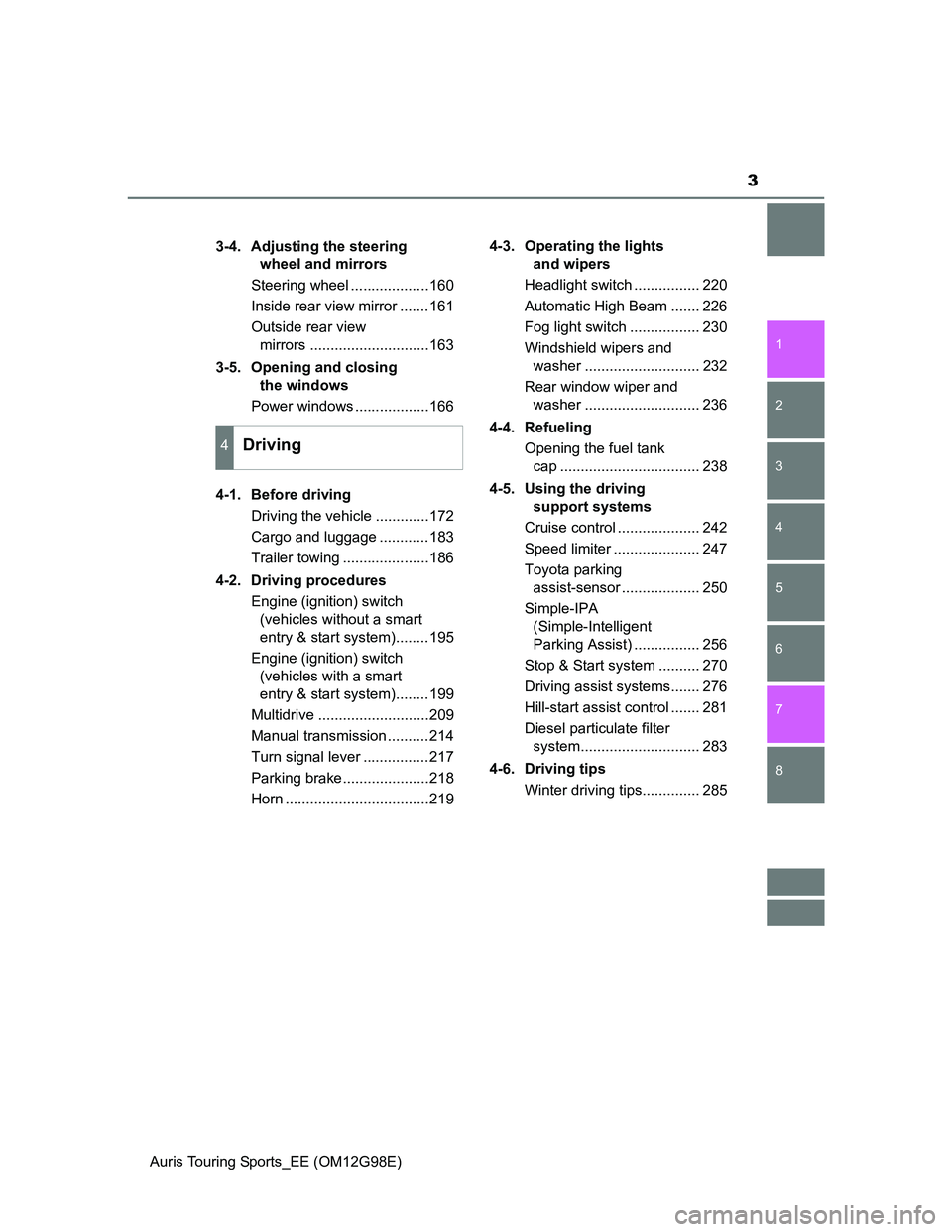
3
1
8 7
6
5
4
3
2
Auris Touring Sports_EE (OM12G98E)3-4. Adjusting the steering
wheel and mirrors
Steering wheel ...................160
Inside rear view mirror .......161
Outside rear view
mirrors .............................163
3-5. Opening and closing
the windows
Power windows ..................166
4-1. Before driving
Driving the vehicle .............172
Cargo and luggage ............183
Trailer towing .....................186
4-2. Driving procedures
Engine (ignition) switch
(vehicles without a smart
entry & start system)........195
Engine (ignition) switch
(vehicles with a smart
entry & start system)........199
Multidrive ...........................209
Manual transmission ..........214
Turn signal lever ................217
Parking brake.....................218
Horn ...................................2194-3. Operating the lights
and wipers
Headlight switch ................ 220
Automatic High Beam ....... 226
Fog light switch ................. 230
Windshield wipers and
washer ............................ 232
Rear window wiper and
washer ............................ 236
4-4. Refueling
Opening the fuel tank
cap .................................. 238
4-5. Using the driving
support systems
Cruise control .................... 242
Speed limiter ..................... 247
Toyota parking
assist-sensor ................... 250
Simple-IPA
(Simple-Intelligent
Parking Assist) ................ 256
Stop & Start system .......... 270
Driving assist systems....... 276
Hill-start assist control ....... 281
Diesel particulate filter
system............................. 283
4-6. Driving tips
Winter driving tips.............. 285
4Driving
Page 5 of 632
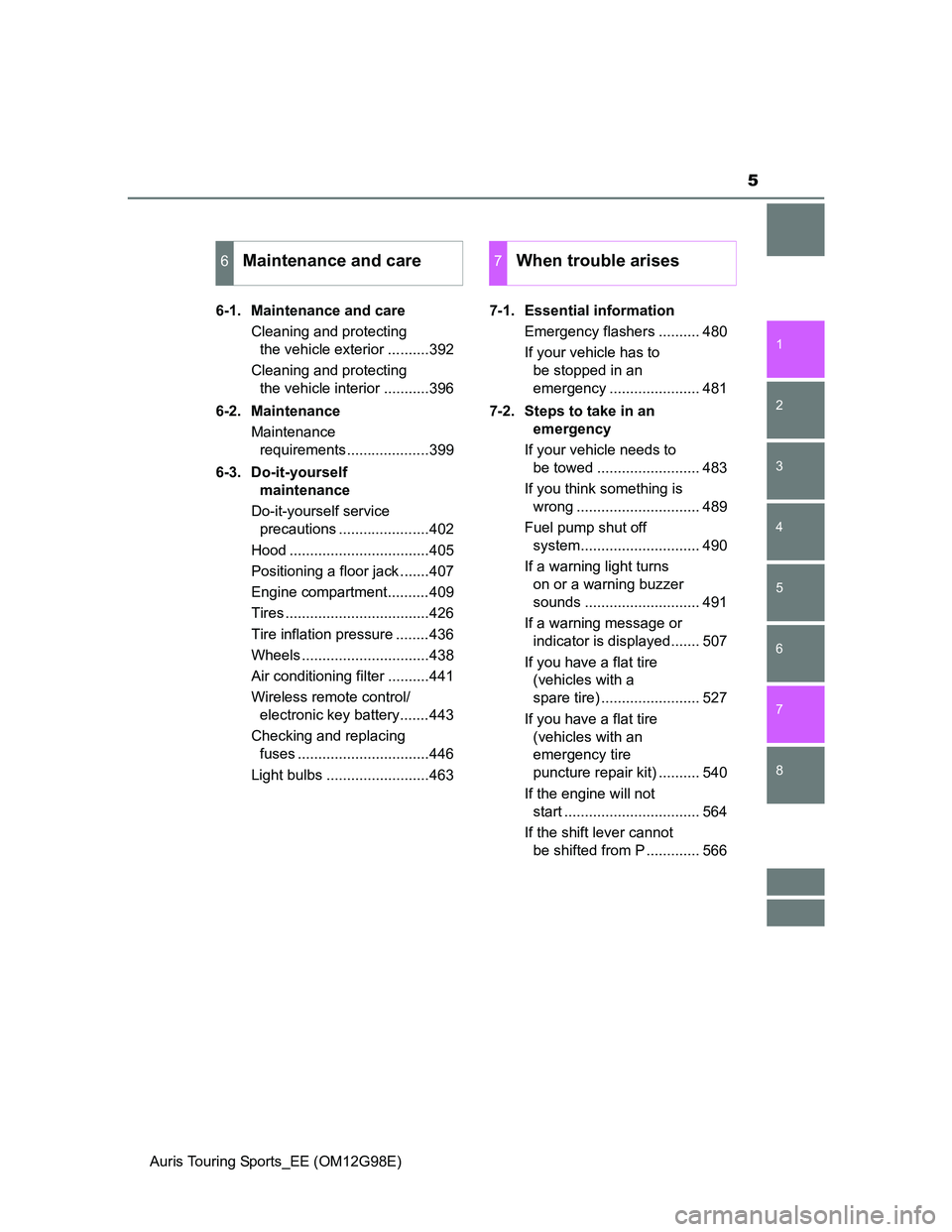
5
1
8 7
6
5
4
3
2
Auris Touring Sports_EE (OM12G98E)6-1. Maintenance and care
Cleaning and protecting
the vehicle exterior ..........392
Cleaning and protecting
the vehicle interior ...........396
6-2. Maintenance
Maintenance
requirements....................399
6-3. Do-it-yourself
maintenance
Do-it-yourself service
precautions ......................402
Hood ..................................405
Positioning a floor jack .......407
Engine compartment..........409
Tires ...................................426
Tire inflation pressure ........436
Wheels ...............................438
Air conditioning filter ..........441
Wireless remote control/
electronic key battery.......443
Checking and replacing
fuses ................................446
Light bulbs .........................4637-1. Essential information
Emergency flashers .......... 480
If your vehicle has to
be stopped in an
emergency ...................... 481
7-2. Steps to take in an
emergency
If your vehicle needs to
be towed ......................... 483
If you think something is
wrong .............................. 489
Fuel pump shut off
system............................. 490
If a warning light turns
on or a warning buzzer
sounds ............................ 491
If a warning message or
indicator is displayed....... 507
If you have a flat tire
(vehicles with a
spare tire) ........................ 527
If you have a flat tire
(vehicles with an
emergency tire
puncture repair kit) .......... 540
If the engine will not
start ................................. 564
If the shift lever cannot
be shifted from P ............. 566
6Maintenance and care7When trouble arises
Page 16 of 632
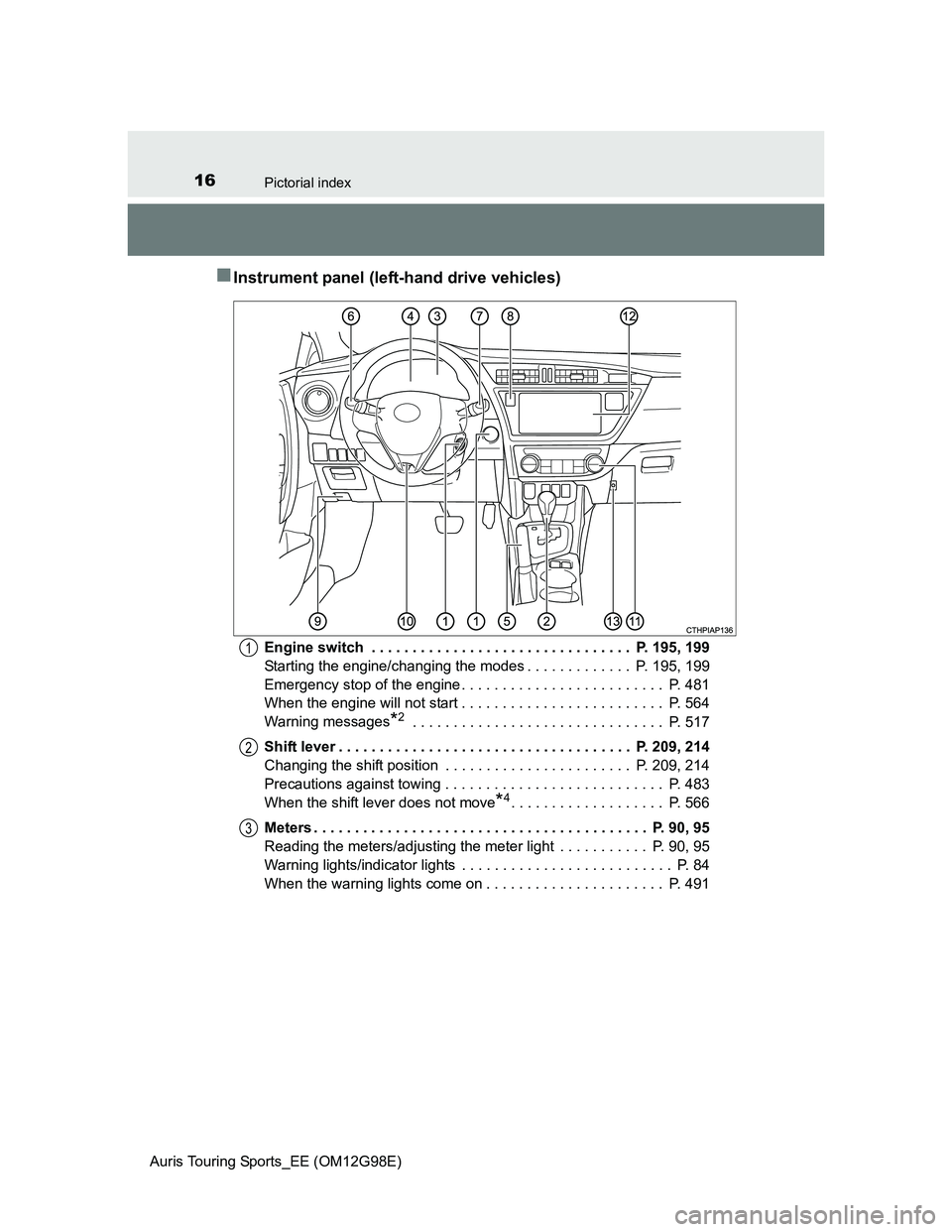
16Pictorial index
Auris Touring Sports_EE (OM12G98E)
Instrument panel (left-hand drive vehicles)
Engine switch . . . . . . . . . . . . . . . . . . . . . . . . . . . . . . . . P. 195, 199
Starting the engine/changing the modes . . . . . . . . . . . . . P. 195, 199
Emergency stop of the engine . . . . . . . . . . . . . . . . . . . . . . . . . P. 481
When the engine will not start . . . . . . . . . . . . . . . . . . . . . . . . . P. 564
Warning messages
*2 . . . . . . . . . . . . . . . . . . . . . . . . . . . . . . . P. 517
Shift lever . . . . . . . . . . . . . . . . . . . . . . . . . . . . . . . . . . . . P. 209, 214
Changing the shift position . . . . . . . . . . . . . . . . . . . . . . . P. 209, 214
Precautions against towing . . . . . . . . . . . . . . . . . . . . . . . . . . . P. 483
When the shift lever does not move
*4. . . . . . . . . . . . . . . . . . . P. 566
Meters . . . . . . . . . . . . . . . . . . . . . . . . . . . . . . . . . . . . . . . . . P. 90, 95
Reading the meters/adjusting the meter light . . . . . . . . . . . P. 90, 95
Warning lights/indicator lights . . . . . . . . . . . . . . . . . . . . . . . . . . P. 84
When the warning lights come on . . . . . . . . . . . . . . . . . . . . . . P. 491
1
2
3
Page 22 of 632
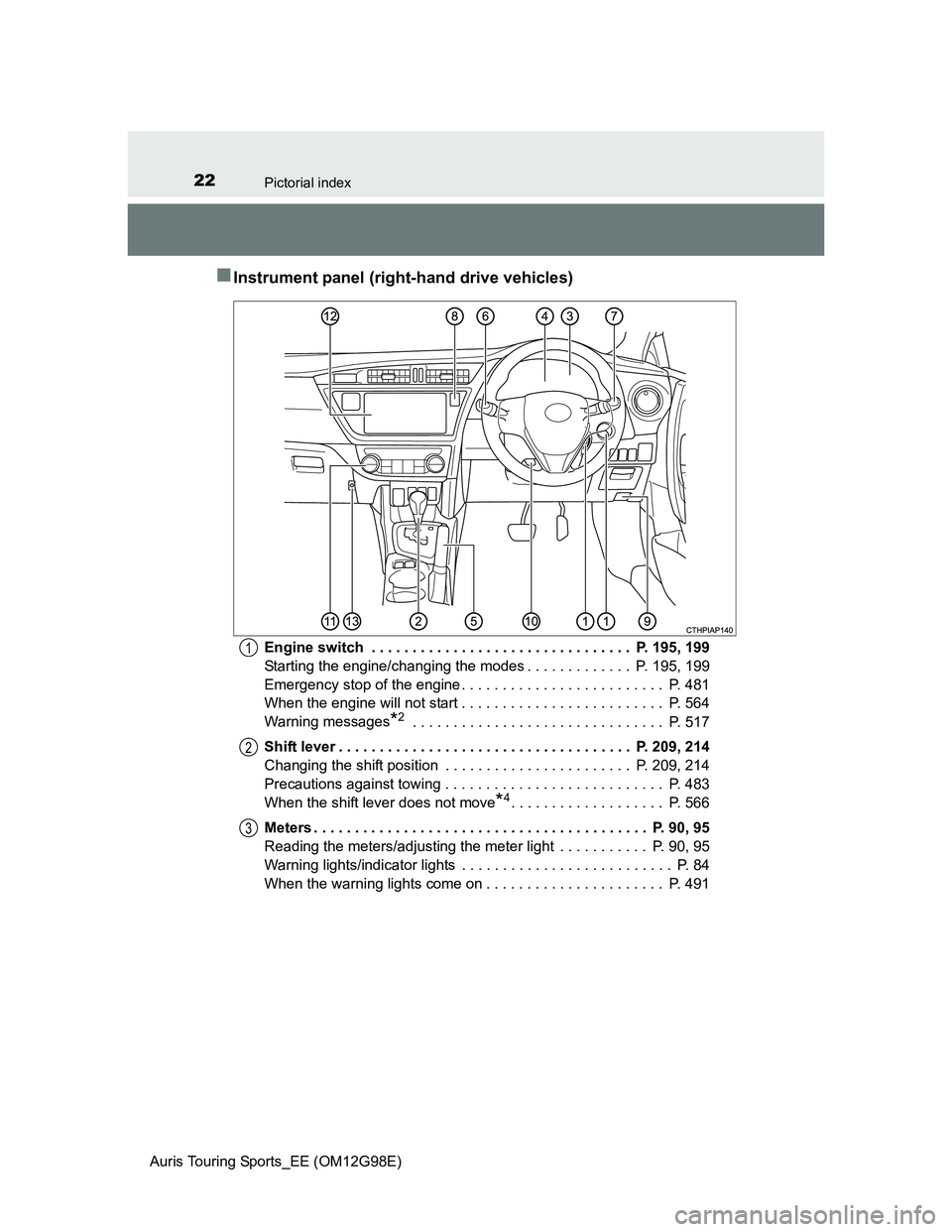
22Pictorial index
Auris Touring Sports_EE (OM12G98E)
Instrument panel (right-hand drive vehicles)
Engine switch . . . . . . . . . . . . . . . . . . . . . . . . . . . . . . . . P. 195, 199
Starting the engine/changing the modes . . . . . . . . . . . . . P. 195, 199
Emergency stop of the engine . . . . . . . . . . . . . . . . . . . . . . . . . P. 481
When the engine will not start . . . . . . . . . . . . . . . . . . . . . . . . . P. 564
Warning messages
*2 . . . . . . . . . . . . . . . . . . . . . . . . . . . . . . . P. 517
Shift lever . . . . . . . . . . . . . . . . . . . . . . . . . . . . . . . . . . . . P. 209, 214
Changing the shift position . . . . . . . . . . . . . . . . . . . . . . . P. 209, 214
Precautions against towing . . . . . . . . . . . . . . . . . . . . . . . . . . . P. 483
When the shift lever does not move
*4. . . . . . . . . . . . . . . . . . . P. 566
Meters . . . . . . . . . . . . . . . . . . . . . . . . . . . . . . . . . . . . . . . . . P. 90, 95
Reading the meters/adjusting the meter light . . . . . . . . . . . P. 90, 95
Warning lights/indicator lights . . . . . . . . . . . . . . . . . . . . . . . . . . P. 84
When the warning lights come on . . . . . . . . . . . . . . . . . . . . . . P. 491
1
2
3
Page 40 of 632
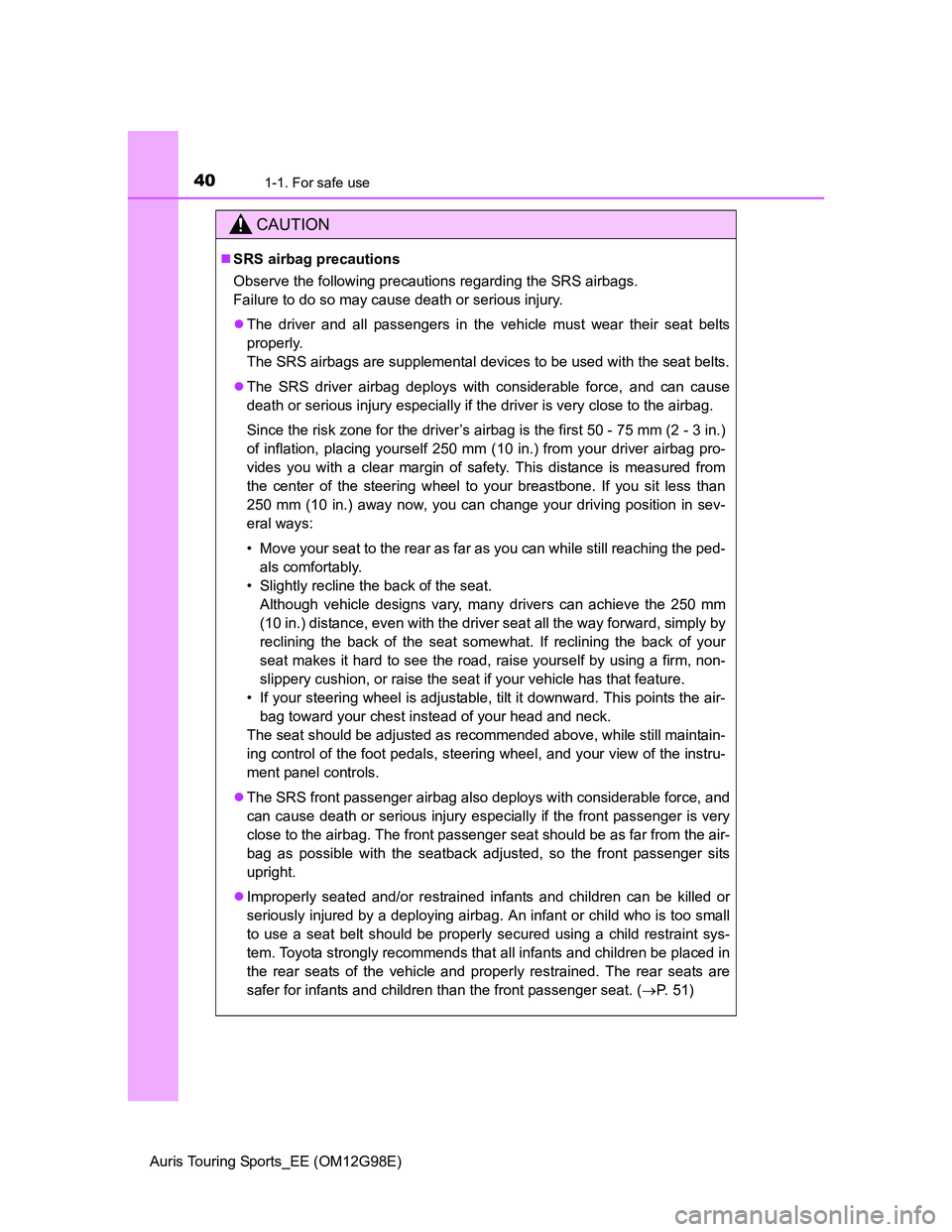
401-1. For safe use
Auris Touring Sports_EE (OM12G98E)
CAUTION
SRS airbag precautions
Observe the following precautions regarding the SRS airbags.
Failure to do so may cause death or serious injury.
The driver and all passengers in the vehicle must wear their seat belts
properly.
The SRS airbags are supplemental devices to be used with the seat belts.
The SRS driver airbag deploys with considerable force, and can cause
death or serious injury especially if the driver is very close to the airbag.
Since the risk zone for the driver’s airbag is the first 50 - 75 mm (2 - 3 in.)
of inflation, placing yourself 250 mm (10 in.) from your driver airbag pro-
vides you with a clear margin of safety. This distance is measured from
the center of the steering wheel to your breastbone. If you sit less than
250 mm (10 in.) away now, you can change your driving position in sev-
eral ways:
• Move your seat to the rear as far as you can while still reaching the ped-
als comfortably.
• Slightly recline the back of the seat.
Although vehicle designs vary, many drivers can achieve the 250 mm
(10 in.) distance, even with the driver seat all the way forward, simply by
reclining the back of the seat somewhat. If reclining the back of your
seat makes it hard to see the road, raise yourself by using a firm, non-
slippery cushion, or raise the seat if your vehicle has that feature.
• If your steering wheel is adjustable, tilt it downward. This points the air-
bag toward your chest instead of your head and neck.
The seat should be adjusted as recommended above, while still maintain-
ing control of the foot pedals, steering wheel, and your view of the instru-
ment panel controls.
The SRS front passenger airbag also deploys with considerable force, and
can cause death or serious injury especially if the front passenger is very
close to the airbag. The front passenger seat should be as far from the air-
bag as possible with the seatback adjusted, so the front passenger sits
upright.
Improperly seated and/or restrained infants and children can be killed or
seriously injured by a deploying airbag. An infant or child who is too small
to use a seat belt should be properly secured using a child restraint sys-
tem. Toyota strongly recommends that all infants and children be placed in
the rear seats of the vehicle and properly restrained. The rear seats are
safer for infants and children than the front passenger seat. (P. 51)
Page 41 of 632
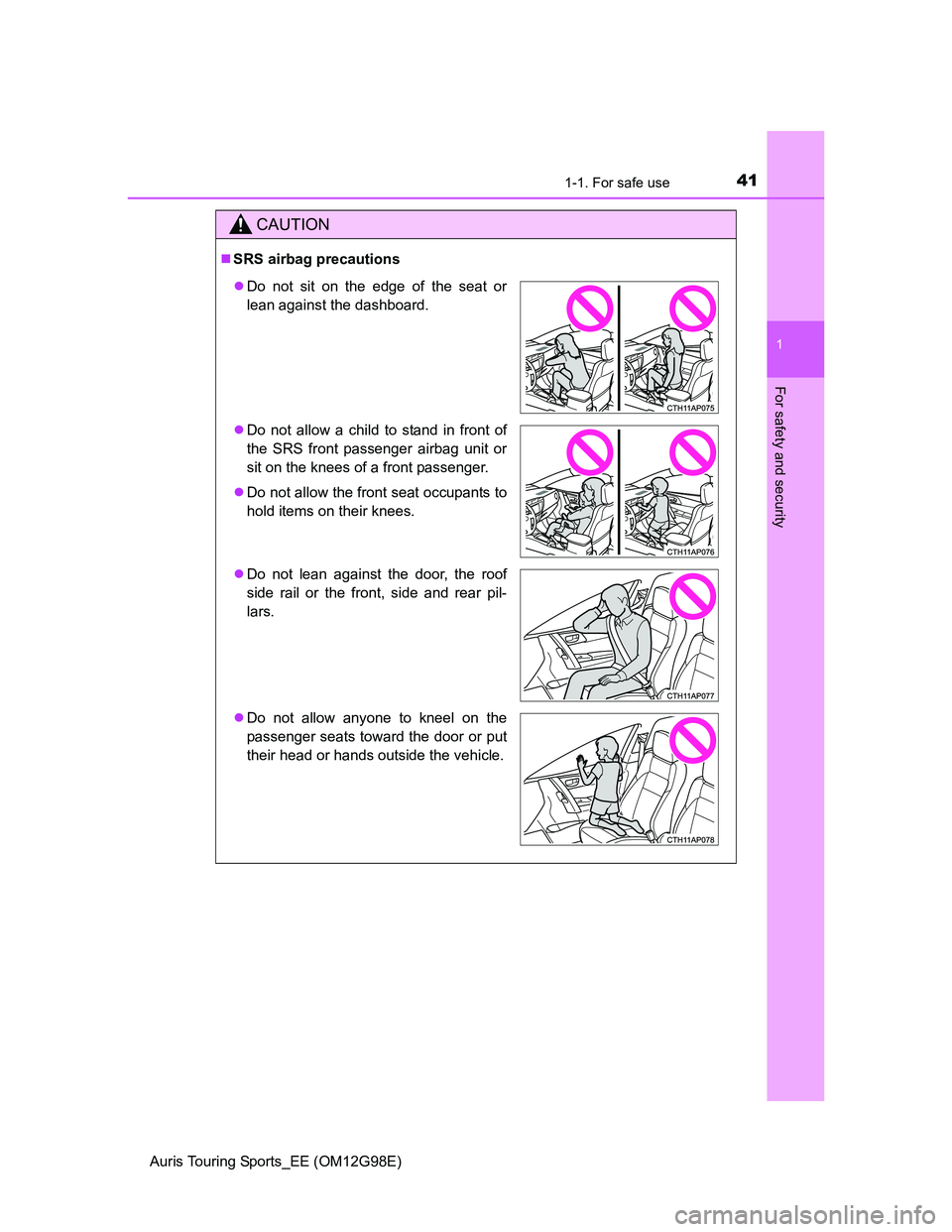
411-1. For safe use
1
For safety and security
Auris Touring Sports_EE (OM12G98E)
CAUTION
SRS airbag precautions
Do not sit on the edge of the seat or
lean against the dashboard.
Do not allow a child to stand in front of
the SRS front passenger airbag unit or
sit on the knees of a front passenger.
Do not allow the front seat occupants to
hold items on their knees.
Do not lean against the door, the roof
side rail or the front, side and rear pil-
lars.
Do not allow anyone to kneel on the
passenger seats toward the door or put
their head or hands outside the vehicle.
Page 115 of 632

1153-1. Key information
Auris Touring Sports_EE (OM12G98E)
3
Operation of each component
Releasing
To release the key, press the but-
ton.
Folding
To stow the key, press the button
then fold the key.
To take out the mechanical key,
push the release button and take
the key out.
The mechanical key can only be
inserted in one direction, as the
key only has grooves on one side.
If the key cannot be inserted in a
lock cylinder, turn it over and re-
attempt to insert it.
After using the mechanical key,
store it in the electronic key. Carry
the mechanical key together with
the electronic key. If the electronic
key battery is depleted or the entry
function does not operate properly,
you will need the mechanical key.
(P. 567)
If you lose your keys
New genuine keys can be made by any authorized Toyota dealer or repairer,
or another duly qualified and equipped professional using the other key (type
A or type B) or mechanical key (type C) and the key number stamped on your
key number plate. Keep the plate in a safe place such as your wallet, not in
the vehicle.
Using the key (type A or type B)
1
2
Using the mechanical key (type C)
Page 123 of 632
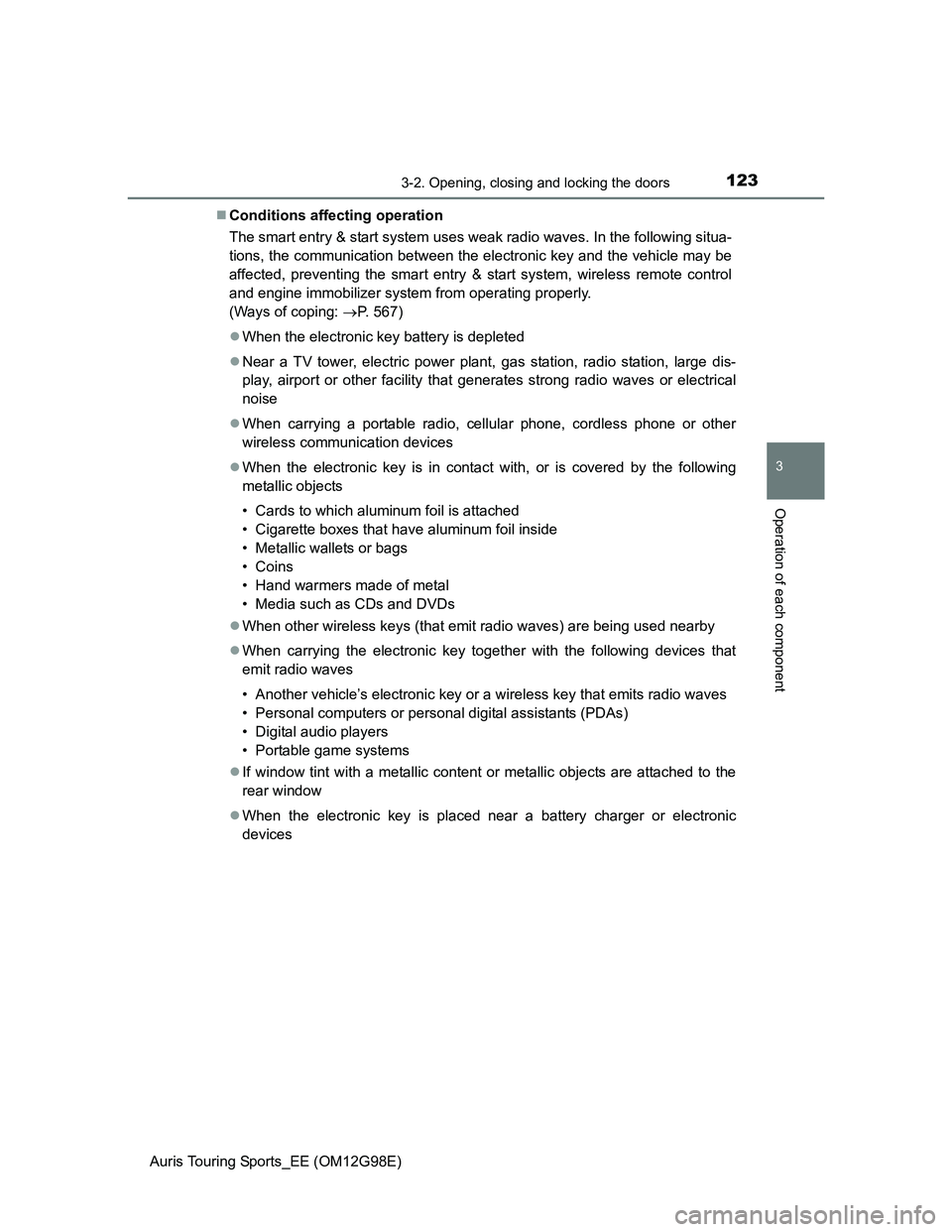
1233-2. Opening, closing and locking the doors
Auris Touring Sports_EE (OM12G98E)
3
Operation of each component
Conditions affecting operation
The smart entry & start system uses weak radio waves. In the following situa-
tions, the communication between the electronic key and the vehicle may be
affected, preventing the smart entry & start system, wireless remote control
and engine immobilizer system from operating properly.
(Ways of coping: P. 567)
When the electronic key battery is depleted
Near a TV tower, electric power plant, gas station, radio station, large dis-
play, airport or other facility that generates strong radio waves or electrical
noise
When carrying a portable radio, cellular phone, cordless phone or other
wireless communication devices
When the electronic key is in contact with, or is covered by the following
metallic objects
• Cards to which aluminum foil is attached
• Cigarette boxes that have aluminum foil inside
• Metallic wallets or bags
• Coins
• Hand warmers made of metal
• Media such as CDs and DVDs
When other wireless keys (that emit radio waves) are being used nearby
When carrying the electronic key together with the following devices that
emit radio waves
• Another vehicle’s electronic key or a wireless key that emits radio waves
• Personal computers or personal digital assistants (PDAs)
• Digital audio players
• Portable game systems
If window tint with a metallic content or metallic objects are attached to the
rear window
When the electronic key is placed near a battery charger or electronic
devices
Page 138 of 632

1383-2. Opening, closing and locking the doors
Auris Touring Sports_EE (OM12G98E)
Operation signals
The emergency flashers flash to indicate that the doors have been locked/
unlocked. (Locked: Once; Unlocked: Twice)
Door lock buzzer (vehicles with a smart entry & start system)
If an attempt to lock the doors is made when a door is not fully closed, a
buzzer sounds continuously for 5 seconds. Fully close the door to stop the
buzzer, and lock the vehicle once more.
Security feature
Vehicles without a smart entry & start system
If a door is not opened within approximately 30 seconds after the vehicle is
unlocked, the security feature automatically locks the vehicle again.
Vehicles with a smart entry & start system
P. 1 1 7
Alarm (if equipped)
Using the wireless remote control to lock the doors will set the alarm system.
(P. 79)
Conditions affecting operation
Vehicles without a smart entry & start system
The wireless remote control function may not operate normally in the follow-
ing situations:
When the wireless key battery is depleted
Near a TV tower, radio station, electric power plant, airport or other facility
that generates strong radio waves
When carrying a portable radio, cellular phone or other wireless communi-
cation devices
When multiple wireless keys are in the vicinity
When the wireless key is in contact with, or is covered by a metallic object
When a wireless key (that emits radio waves) is being used nearby
When the wireless key has been left near an electrical appliance such as a
personal computer
If window tint with a metallic content or metallic objects are attached to the
rear window
Vehicles with a smart entry & start system
P. 123
Page 155 of 632

1553-3. Adjusting the seats
Auris Touring Sports_EE (OM12G98E)
3
Operation of each component
Move the front seats forward. (P. 153)
Stow the rear armrest. (if equipped) (P. 386)
Stow the rear center seat belt
buckle.
Lower the head restraints to the lowest position. (P. 158)
From inside
Pull the seatback lock release
lever and fold the seatback
down.
Each seatback may be folded sep-
arately.
From outside
Pull the lever on the sidewall of
the luggage compartment.
Each seatback may be folded sep-
arately.
Rear seats
The seatbacks of the rear seats can be folded down.
Folding down the rear seatbacks
1
2
3
4
5
5